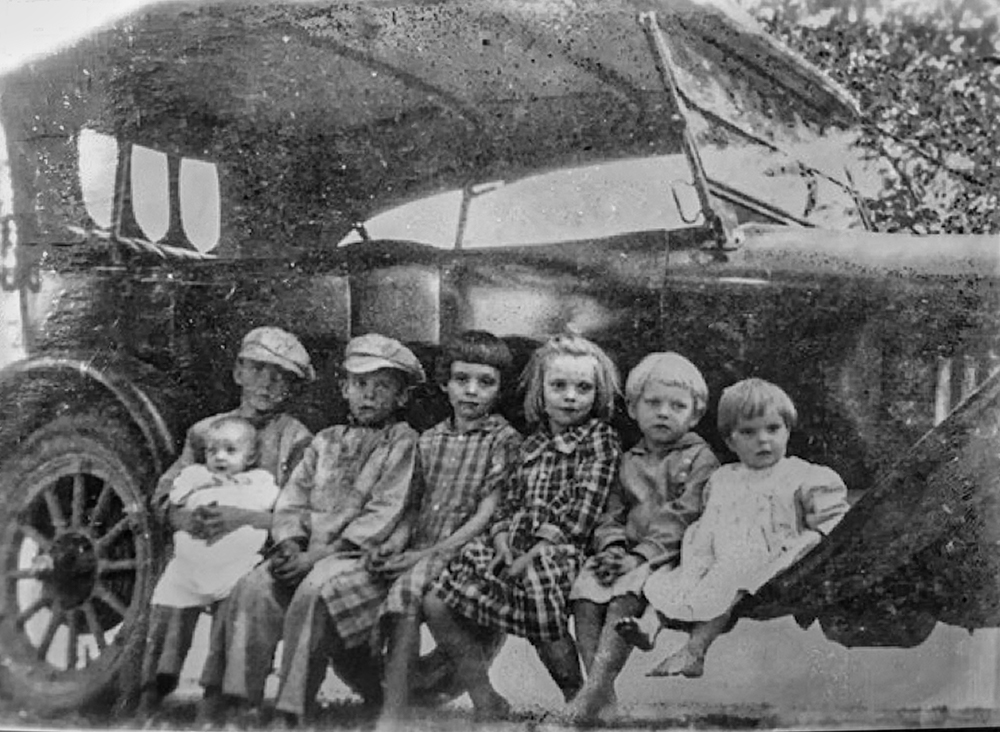The Line-up
by GUEST BLOGGER Linda Stowe
This is a picture of my dad and his siblings. My dad is the second from the left. That is his brother, Paul, sitting next to him. Paul is the oldest of the seven. He is holding their baby brother, known in the family as PeeWee. The picture was taken in 1918, so my dad would have been eight years old at the time.
As I look at the picture, I can clearly recall my dad and each of my aunts and uncles – Paul, Ivan, Elsie, Reba, Edna, Mona, and PeeWee (Ray). Although these seven children were raised in the same home, by the same parents, each one developed a separate and distinct personality. One explanation for those differences is birth order theory.
Birth order theory relates to where each of us was born in the line-up of children in our family. The classic model for this theory is the two-parent family with three children born relatively close together. The theory is not new; it is based on the work of Austrian psychiatrist Alfred Adler in the late 1800s. Adler and other theorists believe that our birth order has a profound and lasting effect on our psychological development. Our birth order shapes who we become and can be used to explain our personalities and the traits we carry throughout our lives.
I first learned about birth order theory in college, and it attracted me right away. It explained why my brother had so many friends, why my sister could be such a prima donna, and why I was the most responsible child in the family.
According to Kevin Lehman (author of The Birth Order Book, 1985), first-borns tend to be reliable, organized, and scholarly. Other researchers add loyal, conservative, with a tendency to be people-pleasers to the mix. Why? There are two reasons: Mom and Dad. Children want the attention of their parents, so they behave in such a way that they get it.
First-borns receive more parental attention and, therefore, have higher expectations placed upon them. Their only role models are their parents. This causes first-borns to be more achievement oriented. They learn responsibility early in life. Childcare and household responsibilities are often passed on to them to free parents for children born later. For this reason, first-born children are well suited for leadership roles later in life. To illustrate, 24 of the first 44 presidents of the U.S. have been either first-born children or first-born sons.
When the next child arrives, the first-born steps aside to share parental attention. The middle child does not get all the attention the first-born got and, as later children come along, the middle child can get lost in the crowd. He might even feel like an outsider.
Literature describes the middle child as the child with the fewest pictures in the family album, the one who avoids conflict, the most independent with a strong loyalty to peer groups, and the one with the most friends. This makes sense because the middle child is sometimes the forgotten child in his own family. Branching off or breaking away from the family unit is a significant feature of middle children as they turn to friends and others for relationships not available to them at home. This can be particularly true if the oldest child is a high achiever. The middle child often assumes the role of family peacemaker because he feels more vulnerable in family drama. These skills of compromise and negotiation serve the middle child well in relating to people throughout their lives.
When the last-born arrives, the other kids scoot over to make room. Last-borns tend to be more affectionate, precocious, and charming. This is no accident. Last-borns quickly learn to “read” people to achieve their needs. As the youngest child, they are the most vulnerable in the family and must rely upon their own wits to vie for the limited resources in the family.
By the time the last-born arrives, the parents are less tense and maybe a bit tired. Therefore, last-borns feel less pressure to achieve or to assume responsibility. But they don’t measure success by these standards. Their strength lies in the relationships they build with others. The last-born’s ability to read people can also have a downside because they can sometimes be seen as manipulative and spoiled. But, then, first-borns can be seen as controlling and bossy, and middle children can seem disconnected from the family.
First-born children tend to be responsible because that was their role in the family. Middle children are often more independent because they had to be. And the last-borns are the charmers because that’s how they got noticed. Of course, these descriptions are broad strokes. There are many variables that can affect the balance – only children, sex of the children, years between births, and individual situations within the family.
But, for me, this explains why all these decades later, I am still depended upon to be the senior advisor in our sibling group. Once a first-born, always a first-born.
